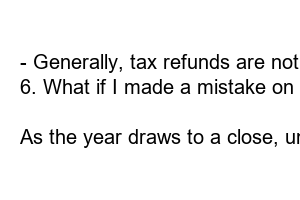연말정산 환급금 미리 보기
Title: A Sneak Peek into Your Year-End Tax Refund
Introduction:
With the year swiftly coming to an end, it’s time to shift our focus to a subject that can bring a smile to many faces – tax refunds! As we prepare to bid farewell to 2021, this blog post will provide you with a preview of what to expect from your year-end tax refund. So grab a cup of coffee, sit back, and let’s dive into the intriguing world of tax refunds!
1. Understanding Tax Refunds:
Before we venture into the specifics of year-end tax refunds, let’s brush up on the basics. Tax refunds are the result of overpaying taxes throughout the year. Come tax-filing season, you may find yourself with a pleasant surprise in the form of a refund – money that is rightfully yours.
2. Assessing Your Tax Situation:
To get a clearer picture of your year-end tax refund, it’s crucial to assess your tax situation. Did you experience any major life changes? Have you made any significant deductions or contributions? Analyzing these factors will help you estimate the size of your refund.
3. Tax Breaks and Deductions:
Take advantage of available tax breaks and deductions to maximize your refund. **Contributions to retirement accounts**, educational expenses, and certain medical expenses are just a few examples of deductions that can reduce your taxable income. By exploring these deductions, you can potentially increase the size of your refund.
4. Filing Status Impact:
Your filing status can play a role in determining the amount you receive as a tax refund. Whether you file as an individual, head of household, married filing jointly, or separately – each status has its own set of implications. Understanding these distinctions can help you plan your financial decisions accordingly.
5. The Importance of Timely Filing:
Filing your tax return early can be advantageous when it comes to receiving your refund promptly. Waiting until the last minute may cause unnecessary delays. By **e-filing** your return and opting for direct deposit, you can speed up the process and ensure your refund hits your bank account sooner.
6. Dealing with Unexpected Outcomes:
Despite our best efforts, sometimes we receive an unexpected outcome when filing our tax returns. Perhaps you owe taxes instead of receiving a refund or your refund is smaller than anticipated. In such cases, it’s essential to evaluate your financial situation and seek advice from a tax professional to address any concerns.
FAQs (Frequently Asked Questions):
1. How long does it take to receive a tax refund?
– It typically takes about 21 days for the IRS to process refunds filed electronically.
2. Can I check the status of my refund?
– Yes, you can check the status of your refund using the “Where’s My Refund?” tool on the IRS website.
3. Can I track my refund after it has been deposited?
– Yes, you can track your refund through your bank’s online banking system.
4. Can I use my tax refund to pay off debts?
– Absolutely! Many individuals choose to use their tax refunds to pay off debts or contribute to savings.
5. Are tax refunds taxable?
– Generally, tax refunds are not taxable. However, if you claimed deductions in the previous year, a portion of your refund may be taxable.
6. What if I made a mistake on my tax return?
– In case of an error, you can file an amended tax return to correct any mistakes and ensure accurate tax calculations.
Summary:
As the year draws to a close, understanding your year-end tax refund can uncover exciting possibilities. Consider factors such as tax breaks, deductions, filing status, timely filing, and seeking professional advice to make the most of your refund potential. Remember to stay informed, track your refund, and utilize it wisely to get a head start on your financial goals for the coming year. Happy tax season!

